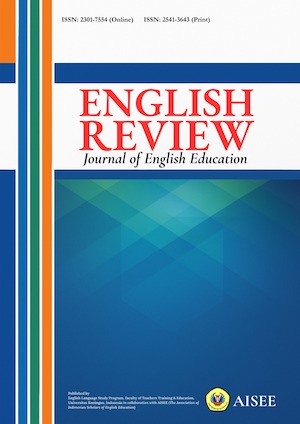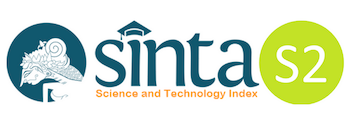A GENRE-BASED APPROACH IN TEACHING MULTIMODAL TEXTS
Abstract
Abstract: This research aims to investigate how the teaching and learning processes of English Education Program Students occur in creating multimodal texts using the Genre Based Approach teaching method. The study seeks to demonstrate that Genre Based Approach, as a teaching method for academic reading and writing courses, can assist students in creating their own multimodal texts, which combine words and images. Participatory Case Study is employed as the research design, aiming to delve deeper into the phenomenon of teaching and learning processes within it. The use of field notes in each phase of the learning activities is crucial in this research as it clearly records interactions between lecturers and students in the classroom. This study provides evidence that the analysis based on the Image Framework analysis (O'Halloran, 2008) in collaboration with the Transitivity System from Systemic Functional Linguistics (Emilia, 2014) enables students to comprehend multimodal texts, analyze them, and ultimately create their own multimodal texts using the genre of analytical exposition. The results of this research demonstrate that the Genre Based Approach teaching process, conducted over 14 sessions from February 21 to April 10, 2024, has improved the reading and writing abilities of fourth-semester students who will be undertaking the PLP program in their fifth semester. This improvement is evidenced by the pre-test and post-test results, which measured understanding of multimodal texts and the production of multimodal texts.
References
Ajayi, L. (2012). How Teachers Deploy Multimodal Textbooks to Enhance English Language Learning. Journal 16 TESOL Journal, 6(1), 16–35.
Cope, B., & Kalantzis, M. (2009). “Multiliteracies”: New Literacies, New Learning. In Pedagogies: An International Journal (Vol. 4, Issue 3). https://doi.org/10.1080/15544800903076044
Derewianka, B. (2003). Trends and issues in genre-based approaches. RELC Journal, 34(2), 133–154. https://doi.org/10.1177/003368820303400202
Dörnyei, Z. (2007). Research Methods in Applied Linguistics (Oxford Applied Linguistics) by Zoltán Dörnyei (z-lib.org).pdf (p. 336).
Emilia, E. (2005). A CRITICAL GENRE-BASED APPROACH TO TEACHING ACADEMIC WRITING IN A TERTIARY EFL CONTEXT IN INDONESIA. University of Melbourne, 1(2), 1–7.
Emilia, E., & Hamied, F. A. (2015). Systemic Functional Linguistic Genre Pedagogy (Sfl Gp) in a Tertiary Efl Writing Context in Indonesia. TEFLIN Journal - A Publication on the Teaching and Learning of English, 26(2), 155. https://doi.org/10.15639/teflinjournal.v26i2/155-182
Emilia, E., Pujianto, D., & Sudarsono, M. I. (2014). A process-genre approach to teaching writing report text to senior high school students. Indonesian Journal of Applied Linguistics, 4(1), 99–110. https://doi.org/10.17509/ijal.v4i1.603
Gerot, & Wignell. (2013). Making Sense of Functional Grammar. https://doi.org/10.1515/9783110800487.39
Greenwood, DavyddJ; Whyte, William and Harkavy, I. (1986). from the SAGE Social Science Collections . Rights Reserved . The American Academy of Political and Social Science, 503(1), 122–136.
Halliday, M. A. K. and C. M. (2004). An Introduction to Functional Grammar (Third Edit, Issue December). Oxford University Press. https://www.functionalmedicine.org/files/library/Intro_Functional_Medicine.pdf
Halliday, M. A. K., & Matthiessen, C. M. I. M. (2013). Halliday’s introduction to functional grammar: Fourth edition. In Halliday’s Introduction to Functional Grammar: Fourth Edition. https://doi.org/10.4324/9780203431269
Hamied, F. A. (2012). English in Multicultural and Multilingual. English as an International Language in Asia: Implications for Language Education, 63–78. https://doi.org/10.1007/978-94-007-4578-0
Hasibuan, K., & Agustina, E. (2023). Exploring the Similarities and Differences among the Kinds of Curriculum Implemented in Indonesian Schools. 2(1), 55–64.
Hidayati, I. N., & Rahmah, M. (2023). The Implementation of Genre-Based Approach in Teaching to Write Advertising Text through Lesson Study. 258–265.
Kaminski, A. (2019). Young learners’ engagement with multimodal texts. ELT Journal, 73(2), 175–185. https://doi.org/10.1093/elt/ccy060
Kartika-Ningsih, H., & Gunawan, W. (2019). Recontextualisation of genre-based pedagogy: The case of Indonesian EFL classrooms. Indonesian Journal of Applied Linguistics, 9(2), 335–347. https://doi.org/10.17509/ijal.v9i2.20231
Liu, C., & Chen, M. (2022). A genre-based approach in the secondary school English writing class: Voices from student-teachers in the teaching practicum. Frontiers in Psychology, 13(September), 1–15. https://doi.org/10.3389/fpsyg.2022.992360
Putra, H., Mujiyanto, J., Astuti, P., & Syafri, F. (2023). The Effectiveness of Genre Based Approach To Enhance The Speaking Performance of Junior High School Students At Sekolah Alam CEFA Kabupaten Kampar Riau Registered 2022 / 2023 Academic Years. International Conference on Science, Education and Technology (2023) Universitas Negeri Semarang, 320–327.
Ripalga, R., & Fitrawati, F. (2023). An Analysis of Questions on Reading Tasks in the English Textbook “Work in Progress” in Merdeka Curriculum. Journal of English Language Teaching , 12(2), 570–581. https://doi.org/10.24036/jelt.v12i2.123128
Suherdi, D. (2015). PROCEEDING The 62 nd TEFLIN International Conference 2015 ISBN: … MULTIMODAL PEDAGOGY IN TEFLIN CONTEXTS.
Syarifah, E. F., & Gunawan, W. (2016). Scaffolding in the Teaching of Writing Discussion Texts Based on SFL Genre-based Approach. English Review: Journal of English Education, 4(1), 39. https://doi.org/10.25134/erjee.v4i1.306
Thompson, M. (2008). Multimodal teaching and learning: Creating spaces for content teachers. Journal of Adolescent & Adult Literacy. https://doi.org/10.1598/JAAL.52.2.5
All articles published in English Review: Journal of English Education (ERJEE) are licensed under the Creative Commons Attribution 4.0 International License (CC BY 4.0).
Copyright Ownership
Authors retain the copyright of their articles and grant ERJEE the right of first publication. The journal is granted a non-exclusive license to publish, reproduce, and distribute the article in any format, medium, or platform, provided that proper credit is given to the original authors.
License Terms – CC BY 4.0
Under the Creative Commons Attribution 4.0 International License, others are free to:
- Share — copy and redistribute the material in any medium or format
- Adapt — remix, transform, and build upon the material for any purpose, even commercially
As long as they:
- Provide appropriate credit to the original author(s) and source
- Provide a link to the license (https://creativecommons.org/licenses/by/4.0/)
- Indicate if any changes were made
There are no restrictions on the reuse, reproduction, or adaptation of published articles as long as attribution is properly given.
Author Warranties
By submitting a manuscript to ERJEE, authors confirm that:
- The work is original and does not infringe any existing copyright.
- The manuscript has not been previously published and is not under consideration elsewhere.
- All sources and references are appropriately acknowledged.
- Necessary permissions have been obtained for any copyrighted materials used.









